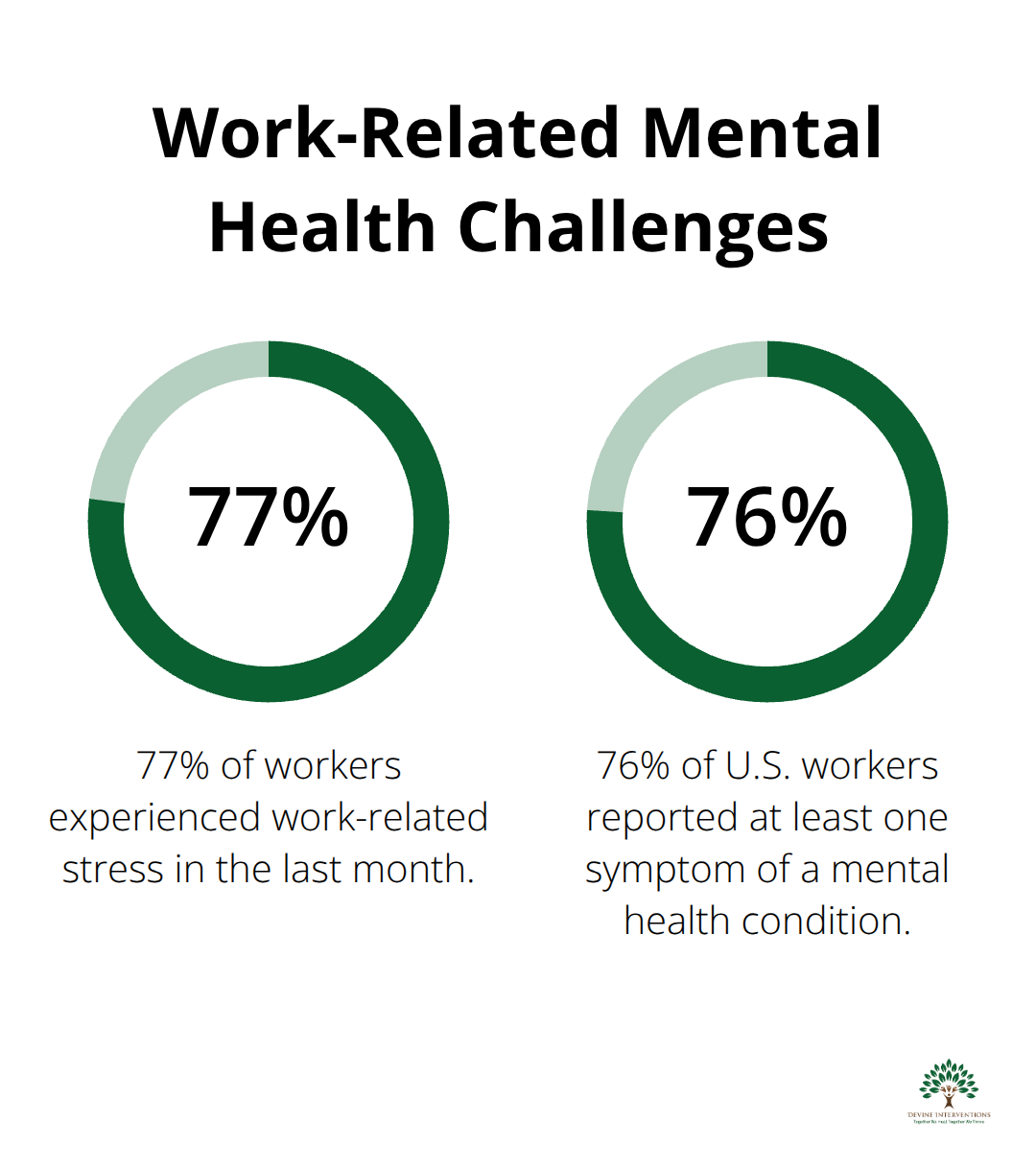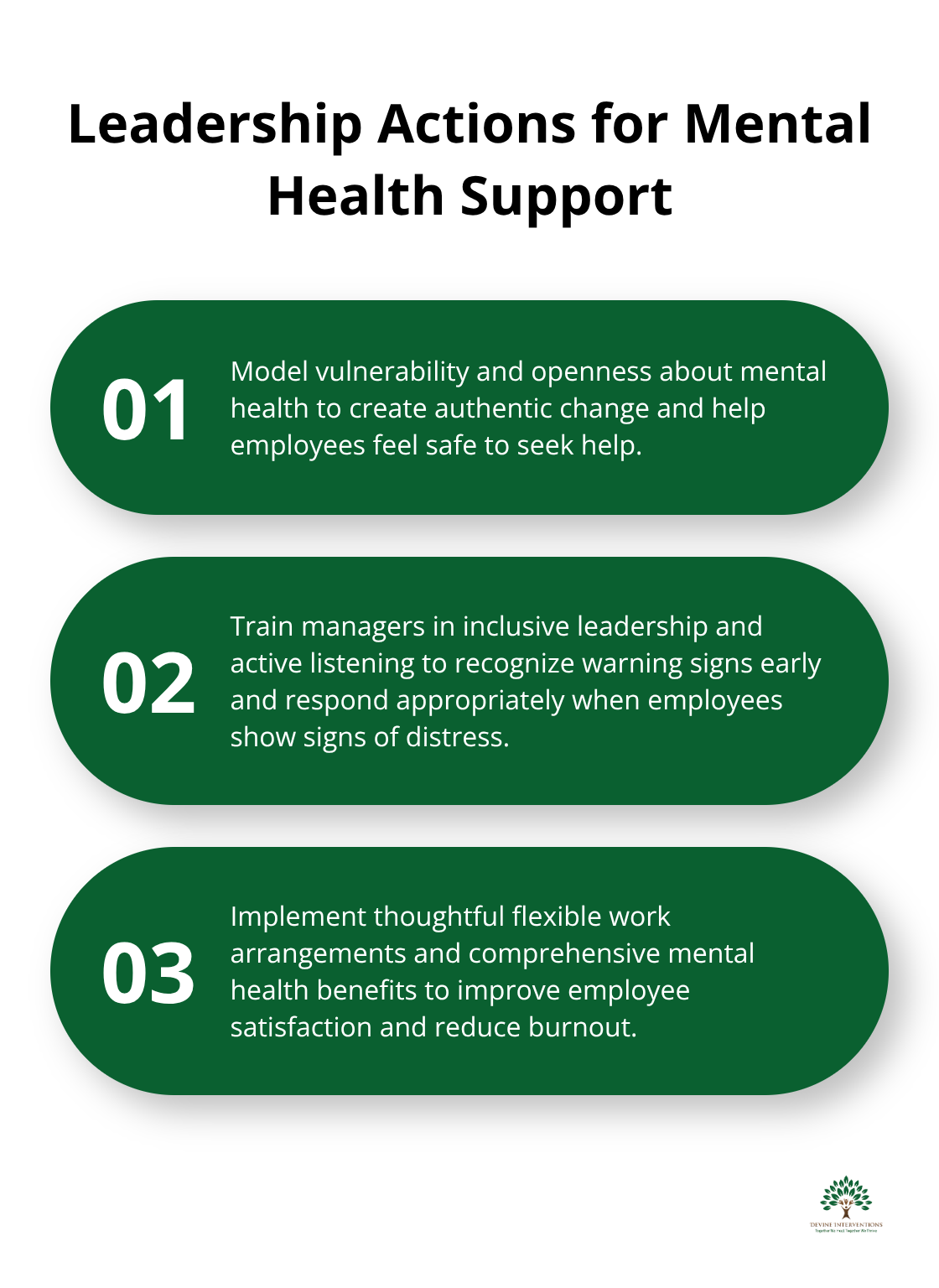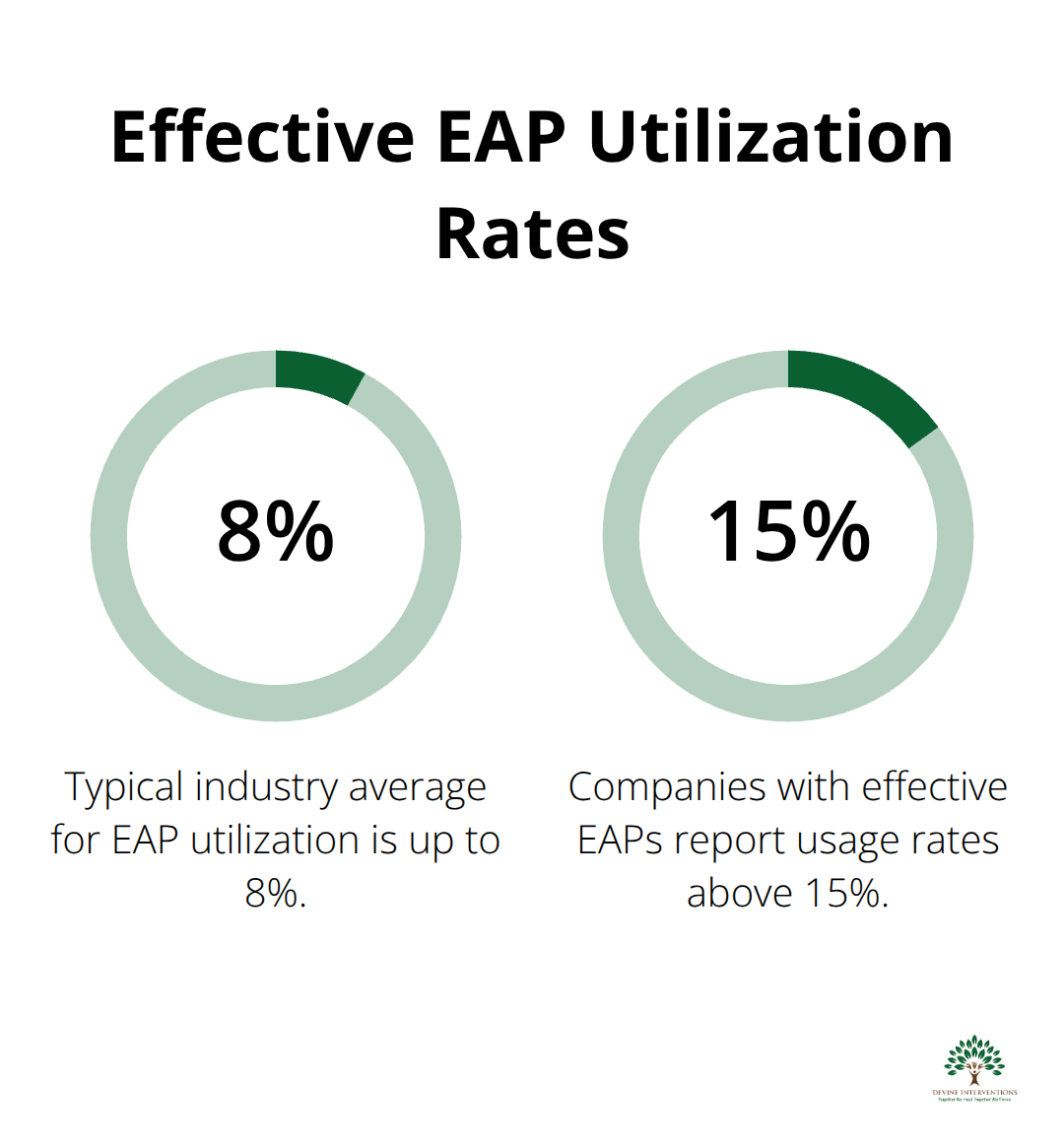Mental health challenges affect 1 in 5 employees annually, yet many workplaces still struggle to address these issues effectively. The importance of mental wellness in the workplace extends far beyond individual well-being.
At Devine Interventions, we understand that creating supportive work environments requires intentional strategies and genuine commitment. This guide provides actionable steps to build a mentally healthier workplace for everyone.
What Mental Health Issues Actually Cost Your Business
Employee mental health conditions drain workplace productivity in measurable ways. The American Psychological Association found that 77% of workers experienced work-related stress in the last month, while 76% of U.S. workers reported at least one symptom of a mental health condition according to MindShare Partners’ 2021 Mental Health at Work Report. Depression and anxiety alone cause the loss of 12 billion workdays globally each year, costing $1 trillion in lost productivity according to the World Health Organization. Employees with poor mental health report 12 unplanned absences per year compared to 2.5 days for those with better mental health, based on Gallup research.

The Real Financial Impact on Operations
The numbers paint a stark picture of workplace mental health costs. Untreated mental health issues cost U.S. employers billions annually through lost productivity and increased absenteeism. Workers who experience mental health challenges show decreased focus, miss deadlines, and produce higher error rates that directly affect bottom-line results. Companies lose talented employees when 81% of workers prioritize employers who support mental health according to the American Psychological Association’s 2022 Work and Well-being Survey.
Warning Signs That Demand Immediate Action
Managers must recognize specific behavioral changes that signal mental health struggles. Watch for employees who frequently call in sick, miss deadlines they previously met easily, or withdraw from team interactions. Physical signs include fatigue, changes in appearance, or difficulty concentrating during meetings. The MindShare Partners report revealed that 84% of employees believe workplace conditions contributed to their mental health challenges.
The Hidden Costs of Workplace Stress
Work-related stress creates a cascade of problems that extend beyond individual employees. Teams suffer when stressed workers struggle to collaborate effectively or communicate clearly with colleagues. Customer service quality drops when employees lack the mental energy to handle difficult situations professionally. These ripple effects compound the direct costs of absenteeism and turnover, creating an environment where problems multiply rather than resolve.
The good news is that organizations can take concrete steps to address these challenges and create supportive environments that benefit everyone.
How Do You Build Workplace Mental Wellness That Actually Works?
Companies must implement systematic changes that address root causes rather than symptoms to create genuine mental wellness. Leadership commitment that goes beyond surface-level initiatives drives real transformation. Organizations that focus on mental wellness see improved retention rates and better talent acquisition according to Deloitte research, but only when they move beyond token gestures to meaningful structural changes.
Leadership Actions That Drive Real Change
Executive teams must model vulnerability and openness about mental health to create authentic change. Leaders who share their own struggles and prioritize mental wellness in decision-making help employees feel safe to seek help. Training managers in inclusive leadership and active listening becomes essential for recognizing warning signs early.

Research shows that workers prioritize work-life balance, with 79% of workers ranking it higher than pay in 2024. Managers need specific training to respond appropriately when employees show signs of distress. This moves beyond generic wellness talks to actionable support systems that employees can trust.
Flexible Work Policies That Reduce Stress
Thoughtful implementation of flexible work arrangements significantly improves mental well-being rather than checkbox initiatives. Predictable and flexible scheduling helps alleviate economic stress among workers, while autonomy in work arrangements enhances employee satisfaction and reduces burnout. Organizations must respect boundaries between work and personal time and model this behavior from the top down.
Private-sector employee access to paid family leave has increased from 12% in 2014 to 27% in 2023, though this still creates unnecessary stress for many employees facing personal challenges. Companies that provide comprehensive mental health benefits (including adequate paid time off and family leave) see measurable improvements in employee engagement and reduced absenteeism rates.
Mental Health Resources That Employees Actually Use
Effective mental health programs require more than basic Employee Assistance Programs that sit unused. Companies must actively promote available resources and make access simple and confidential. Regular mental health awareness workshops and newsletters educate employees and reduce misconceptions about seeking help.
These foundational changes create the groundwork for implementing specific programs and strategies that directly support employee mental wellness on a daily basis.
What Specific Programs Actually Improve Employee Mental Health?
Employee Assistance Programs fail when companies treat them as checkbox solutions rather than integrated support systems. Effective EAPs require active promotion beyond annual enrollment emails, with managers who receive training to make referrals and track utilization rates. Companies that see results from their EAPs report usage rates above 15%, compared to the typical 2.1-8% industry average. The key difference lies in making these programs visible through regular communication, manager training sessions, and removing barriers like complicated referral processes. Organizations should partner with providers who offer 24/7 access, multilingual support, and both in-person and virtual counseling options to meet diverse employee needs.

Stress Management Training That Changes Behavior
Generic stress management workshops produce minimal lasting change compared to targeted skill-building programs. Effective stress management training focuses on specific techniques like cognitive behavioral strategies, mindfulness-based stress reduction, and practical time management skills that employees can apply immediately. Studies show that employees who exercise regularly take fewer sick days. Programs should run for 6-8 weeks with practice assignments between sessions, rather than one-time seminars that employees forget within days. Companies see the best results when they combine individual skill-building with environmental changes that reduce systemic stress sources.
Work-Life Balance Initiatives That Actually Work
True work-life balance requires structural changes beyond flexible hours or remote work options. Organizations must establish clear communication boundaries, such as no emails after specific hours and protected time for focused work without meetings. The most successful companies implement meeting-free time blocks, limit after-hours communication, and provide adequate staffing to prevent chronic overwork. Designated mental health days normalize self-care and reduce stigma (allowing employees to prioritize their well-being without using sick leave). These policies only succeed when leadership models the behavior consistently and holds managers accountable for respecting employee boundaries.
Peer Support Networks That Build Connection
Peer support networks foster community and connection among employees, reducing feelings of isolation that contribute to mental health struggles. Companies that establish formal peer support programs see higher employee engagement scores compared to those without such initiatives. These networks work best when organizations train volunteer peer supporters in basic mental health awareness and active listening skills. Participants report feeling more comfortable discussing challenges with colleagues who understand their work environment. The most effective programs include regular check-ins, confidential support channels, and clear guidelines about when to escalate concerns to professional resources (such as EAPs or management).
Final Thoughts
The importance of mental wellness in the workplace extends beyond individual employee health to organizational success and sustainability. Companies that implement comprehensive mental health strategies see measurable returns through reduced absenteeism, improved retention, and higher productivity levels. The evidence shows that 81% of workers prioritize employers who support mental health, which makes these initiatives essential for talent acquisition and retention.
Organizations that invest in mental wellness programs create competitive advantages while they build stronger, more resilient teams. The financial benefits compound over time as companies reduce turnover costs, decrease healthcare expenses, and improve overall workplace culture. Employees in supportive environments report higher job satisfaction and demonstrate increased loyalty to their employers (particularly when leadership models mental health awareness consistently).
Leadership commitment and systematic implementation of evidence-based strategies form the foundation of successful workplace mental wellness programs. Companies must start with leadership training, establish clear mental health policies, and provide accessible resources that employees actually use. We at Devine Interventions help organizations develop customized mental wellness programs that transform workplace culture and support employees’ long-term success.







